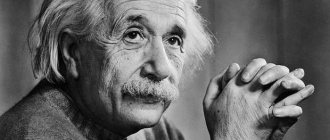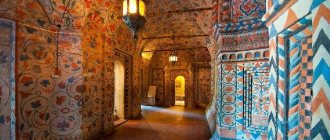Author: Tatyana Soboleva
Publication date: 09/30/2019
Types and synthesis of church arts. The concept of beauty in philosophy and theology. Origin of the arts. Christian (iconological) picture of the world. Origin and essence of liturgical art.
Painting of the dome in the Chora Monastery, Constantinople. 1st quarter XIV century
Types of church arts
Art, as we know, figuratively reflects the real, visible world and appeals primarily to feelings. What are the specifics of church art? Through the “simple five senses”, it tells us the signs of the innermost. Through images, forms, sounds, and even smells and tastes, it reflects the reality that will be revealed in re-existence, the life of the “future century.” It is impossible for a person to solve this problem on his own, but everything is possible for God if a person calls on Him to be the creator of his creations. Therefore, church art is a synergy, the cooperation of the Creator and man.
Traditionally, such areas of church art are distinguished as architecture, painting (icons themselves, as well as monumental painting - frescoes and mosaics), bell casting and bell ringing, small and monumental sculpture (carved icons, icon cases, iconostases; bas-reliefs and round sculpture, made in various techniques), singing, special sewing (gold and embroidery). These may also include the making of incense, and in the past, writing and decorating books. At the same time, in the broadest sense of the word, mastery and art can be achieved in a variety of activities and, by churching them, turn this activity into church activity - i.e. in collaboration with God.
The period of Moscow's rise
In the last third of the 15th century, events occurred that marked the beginning of a new stage in the development of Russian culture. Moscow, having subjugated its rival Novgorod, became the center of the Russian principalities. The long era of monarchy began. Centralization affected both the worldview and the development of Orthodox church art.
The beginning of the Pre-Renaissance resulted in the Renaissance in Rus', being crushed by the reign of Ivan the Terrible. Everyone related to the reform processes was defeated. Many leaders were executed, exiled, and tortured. In the struggle between the non-possessors, who opposed church property, and the Josephites, who followed Joseph Volotsky, who advocated the union of the state and the church, the latter are victorious.
Freedom in a monarchical state is becoming less and less. Its adherents - boyars, princes - die in mass executions. The enslavement of the peasantry occurs, civil liberties disappear, and nobles appear who were the tsar's loyal servants. Then the “master and slaves” model arises in Russian history. Individuality falls into the shackles of the state.
Synthesis of arts in worship
Priest Pavel Florensky
The thinker and theologian Father Pavel Florensky (1882-1937) called church worship a synthesis of the arts. His article, or rather his report, read in October 1918 at a meeting of the Commission for the Protection of Monuments of Art and Antiquity of the Trinity-Sergius Lavra, is called “Temple Action as a Synthesis of Arts.” According to the author, “in a temple... everything is intertwined with everything else: temple architecture, for example, takes into account even such a seemingly small effect as ribbons of bluish incense curling across the frescoes and entwining the pillars of the dome, which with their movement and interweaving almost infinitely expand the architectural spaces of the temple, soften the dryness and hardness of the lines... Let us remember the plasticity and rhythm of the movements of the priests, for example during censing, the play and shimmer of the folds of precious fabrics, the incense, the special fiery winnowing of the atmosphere, ionized by thousands of burning lights; let us further remember that the synthesis of the temple action is not limited only to the sphere of fine arts, but includes vocal art and poetry in its circle - poetry of all kinds, itself being in the plane of aesthetics - musical drama. Here everything is subordinated to a single goal, the supreme effect...” [1].
Metropolitan Pitirim Nechaev
The same idea is developed by Metropolitan. Pitirim (Nechaev) (1926-2003), saying that “beauty, like the Glory of God, fills the temple... this art is not only comforting, but also effective, not only symbolic, but also transformative. Its transformative significance was realized with particular force in the Russian soul, which gave it prophetic expression in the prophetic word of F.M. Dostoevsky: “Beauty will save the world.” This beauty is a manifestation of spiritual Beauty, which is considered one of the criteria of Orthodox churchliness. “What is churchliness? – asked priest Pavel Florensky and answered: This is a new life, life in the Spirit. What is the criterion for the correctness of this life? - Beauty. Yes, there is a special spiritual beauty, and it, elusive to logical formulas, is at the same time the only true path to determining what is Orthodox and what is not... Orthodox taste, Orthodox appearance is felt, but is not subject to arithmetic calculation; Orthodoxy is shown, but not proven. That is why for anyone who wants to understand Orthodoxy there is only one way - direct Orthodox experience” [2]. What is beauty?
Mongol-Tatar yoke
Having passed through Rus' with fire and sword, the Mongol-Tatar tribes destroyed many examples of art of those times. Entire cities with their majestic buildings and craftsmen were destroyed. Vast territories once inhabited by the Slavs lay empty, while Poland, Lithuania and the Livonian Order captured Western Russian lands.
Culture glimmered in Novgorod and the Vladimir-Suzdal principality. But here art experienced a real decline. And only in the 14th century did its rise begin, which was called the Pre-Renaissance.
This was a specific socio-cultural state of society, which was reflected in all types of art. At this time, ideas about individuality and personality arose in the mentality of people, and creators began to search for something new. In Rus' it began to develop under the influence of Byzantium.
The traditions of Novgorod art were attacked by Theophanes the Greek. His energetic brushstrokes, spaces and expression had a massive influence on the art of his times.
At the same time, a national genius of painting appeared - Andrei Rublev. His works reflect humanistic ideas and soft lines. They are considered the true masterpieces of all time. He combined the divine essence and human traits in the same images.
The concept of beauty in philosophy
The mystery of beauty has troubled humanity for centuries. In history, many judgments have been made about her. The most ancient civilizations left monuments that capture the aesthetic views of ancient peoples. The Sumerians already in the 25th century. BC. knew writing. The text “Summer and Winter, or Enlil chooses the patron god of farmers” records the first dispute in the history of mankind about the relationship between the beautiful and the useful. The most useful is considered the most beautiful.
Sumerian cuneiform. III millennium BC
The ancient Egyptians expressed some theoretical ideas about the aesthetic properties of the world. Thus, in a papyrus from the Middle Kingdom, the beauty of the Nile is glorified:
Bringer of bread, abundant food, Creator of everything beautiful...
The hymn praising the sun god Aten reads:
You give life to hearts with your Beauty, which is life.
As we see, among ancient peoples, the attitude to the world retained integrity, and aesthetic interest had not yet been isolated into an independent sphere [3]. Thus, “ancient aesthetics begins as one of the facets of philosophizing about nature” [4]. Natural philosophers (VI century BC) believed that beauty is cosmic perfection, the universal harmony of the universe. In Greek, the word cosmos means simultaneously: the universe and decoration, outfit, beauty, order, harmony. Hence the cosmetics.
The Pythagoreans (VI century BC) associated the concept of beauty with the general picture of the world (harmonious cosmos), as well as with the concept of good. Ugly, in their opinion, is evil. The Pythagoreans approached beauty and from a mathematical point of view, calculating harmony, without which beauty is impossible, they spoke about the music of the spheres. According to the Pythagoreans, the universe is a “beautifully sounding orchestra.” The dialectician Heraclitus (c. 520-c. 460 BC) believed that beauty is forever changing and renewed, and harmony is a dynamic balance. The atomist Democritus (c. 460-c. 370 BC) first put forward the category of measure and developed the hedonistic concept: one should live by enjoying, but “one should not strive for every pleasure, but only for that which is associated with the beautiful.” “Proportion is beautiful in everything,” says Democritus, “I do not like either deficiency or excess.”
Lysippos. Bust of Socrates. Roman copy of the 1st century. Louvre.
Socrates (c. 469-399 BC) was one of the first in history to try to understand what the nature and essence of beauty is. He sets out to answer not only the question “what is beautiful?”, but also “what is beautiful?” This, according to the philosopher, is the best, the most perfect of its kind. The beautiful in Socrates is also useful.
Plato (c. 428-347 BC) in the dialogue “Symposium” writes: “The beautiful exists forever, it is not destroyed, does not increase, does not decrease.” The beautiful appears here as an eternal idea, alien to the changing world of things. This understanding follows from Plato’s philosophical concept, which argued that sensory things are only shadows of ideas. Ideas are unchanging spiritual essences that make up true existence. There is also a higher “idea of ideas.”
Aristotle (384-322 BC), unlike Plato, believed that beauty is not an objective idea, but an objective quality of phenomena. It lies in “size and order.” In his “Poetics” he says that the Beautiful is not too big and not too small, it must be proportionate to man. Aristotle emphasized the unity of the beautiful and the good, the aesthetic and the ethical. Images of art should be as beautiful as they are morally high and pure. Art does not always depict beauty, but it always depicts beauty. The world is beautiful - this thesis has passed through the entire history of ancient aesthetics [5].
In the Middle Ages, the concept of the divine origin of beauty dominated. God, spiritualizing inert matter, gives it aesthetic properties. Thus, the beauty of a thing is its spirituality by God. Sensual beauty and the enjoyment of it are sinful. Medieval aesthetics are ascetic.
Renaissance humanists affirmed the beauty of nature itself and the joy of perceiving it. The aesthetics of the Renaissance continues ancient traditions; the beautiful is identified with the moral and just. External beauty is considered an attribute of virtue. Luca Pacioli (1445-1517) puts forward the standard of beauty - the golden (harmonic) ratio. A person, his body, becomes an example of beauty. Leonardo da Vinci (1452-1519) believed that the most beautiful thing is the perfect proportions of objects. The aesthetics of the Renaissance is imbued with humanism and the search for the truth of life. Shakespeare (1564-1616) believed that art is a mirror that the artist holds up to nature; and “the beautiful is a hundred times more beautiful, crowned with precious truth.” Thus, Renaissance aesthetics emphasized the connection between beauty and truth.
Lysippos. Bust of Aristotle. Roman marble copy.
The aesthetics of classicism, the canonical expression of which was given by Nicolas Boileau (1636-1711), identified the beautiful with the elegant. Not all nature is beautiful in its bloom and riot, but only trimmed and well-groomed, such as, for example, the nature of Versailles Park. Boileau substantiated the principles of good taste. He believed that only the truthful is beautiful. Even the ugly is beautifully depicted in art. Imitating the beauty of nature is the main goal of art. The most complete embodiment of the ideals of beauty for Boileau. - a great personality.
The aesthetics of the French enlighteners (XVIII century) is a new stage in the development of the theory of beauty. Voltaire (1694-1778) asserted the relativity of human ideas about beauty: if you ask a toad what is beautiful, it will answer that the embodiment of beauty is another toad. In the aesthetic code “Temple of Taste,” Voltaire says: “False taste is a product of artificiality, while the mother of true taste is nature itself.” French enlighteners believed that beauty is a natural property of nature itself, the same as weight, color, volume.
The romantic F. Schiller (1759-1805) argued that beauty is freedom, the unconstrained development of phenomena according to their inherent laws. The basis of beauty is simplicity, and perfection is natural. Schiller distinguishes the image of the beautiful from the beautiful image. What is ugly in nature can be beautiful in art (beautiful image).
G.V.F. Hegel (1770-1831) finds in beauty only the sensual appearance of an infinite idea. A beautiful object is one in which the idea is most fully manifested. For Hegel, the concept of the beautiful is pushed into the background by the concept of the true: the deeper a person thinks, the closer to the truth, the less he needs the beautiful. In art, according to Hegel, only that which makes it possible to get closer to the absolute idea is valuable.
Theology of beauty
But beauty is one of the central concepts not only of philosophical and aesthetic thought, but also of theology. The Monk Macarius of Egypt (c. 300-391) writes that a person, wounded by the love of Beauty, is “bound and intoxicated by it, immersed and taken captive to another world.” Nothing awakens the soul more than attention to beauty. In Christianity, Beauty is one of the names of God. God is beautiful in Himself, and He is the source of true beauty [6].
Antonello da Messina. Saint Augustine. 1472 Nat. Palermo gallery.
Here is an amazing hymn to the beauty of St. Augustine (354-430): “I loved You late, true Beauty... You were in me, but I was outside. I sought You externally, disgracing Your proportionate creation with my ugliness. You were with me, but I was without You... You called, and Your cry cut through my deafness; You sparkled, and Your brilliance drove away blindness; Your fragrance has flowed, and now I am suffocating without You... I have tasted You, and now I hunger and thirst; You touched me, and love was kindled in me” [7].
In “Conversations on the Sixth Day” by St. Basil the Great (c. 330-379) speaks as if on behalf of Moses: “The world is a work of art, subject to contemplation by everyone, since through it the wisdom of the Creator is known” [8]. This is a patristic postulate about peace, and Basil the Great remains here a genuine Hellenic, for for the Greeks the world has been a work of art since ancient times [9]. St. Gregory the Theologian (329-389) explains that “beauty is an essential attribute of God,” and St. Cyril of Alexandria (376-444) points out that the beauty of God is supramundane, and man is recreated in this trinitarian beauty, which, according to St. Maximus the Confessor ( 580-662), destined ultimately to be shared with God Himself.
“The Chorus of Patristic Voices” is summed up by Dionysius the Areopagite (1st century): “The saints praise God as the Beautiful, as the Beauty... All that exists, arising from the Beautiful and the Good, being in the Beautiful and the Good, returns to the Beautiful and the Good. And everything that exists and appears exists and appears thanks to the Beautiful and the Good.” Goodness and beauty are identical here [10].
This identity is also confirmed by the ascetic experience of the venerable fathers and ascetics of piety, accumulated over the entire history of Christianity. Already in ancient times, collections of the most authoritative ascetic works of the Holy Fathers in the Church received the name “Philokalia” (love of beauty). The most famous “Philokalia” is a collection of works by Orthodox ascetics, created on Mount Athos in the 18th century. It was translated into Russian with the title “Philokalia”.
Beauty is the criterion of truth
However, beauty is not only identical with goodness. Real beauty can and should also be believed. She confirms. Here, for example, is how priest Pavel Florensky formulated it, analyzing Rublev’s famous “Trinity”: “Of all the philosophical proofs of the existence of God, the most convincing is the one that is not even mentioned in textbooks: approximately it can be constructed by inference: there is a “Trinity” Rublev, therefore, is God.” Beauty is identical to truth, is its criterion, its component. [eleven].
St. Vladimir, Boris and Gleb. Double-sided tablet icon. Novgorod. Con. XV - beginning XVI century Tretyakov Gallery
Suffice it to recall the episode of the “test of faith” in The Tale of Bygone Years. Muslims, Catholics, and Khazar Jews have already spoken with Prince Vladimir. A sermon by a Greek “philosopher” sounded before him, containing biblical history and a short catechism in addition, and it seemed to have already made the right impression: the prince states that the Greeks speak “cunningly” and “wonderfully”, that everyone loves to listen to them. And yet preaching is not enough. It is necessary not only to hear, but also to see. And so Vladimir, on the sensible advice of the boyars and elders, chooses ten “kind and sensible men” so that they can look with their own eyes at the visible reality of each faith - in what form does it appear at home?
The envoys carried out the order. The prayer movements of Muslims in the mosque repulsed them because of the alienness of their rhythm and plasticity and seemed joyless: “there is no joy in them.” The Latin rite also did not provide aesthetic satisfaction: “there is no way to see beauty.” But in Constantinople, the patriarch showed them “the beauty of the church,” and they tell their prince: “We don’t know whether we were in heaven or on earth, for there is no such view and such beauty on earth, and we don’t know how to tell about it, We only know that God is with people there and their worship is better than in all other countries. We cannot forget that beauty.” The word “beauty” is repeated again and again, and the experience of beauty serves as a decisive theological argument: “God dwells there with people.” Now the prince can finally make his choice. “Vladimir answered and said: where will we receive baptism?”
Aesthetic argumentation turned out to be the most convincing. Therefore, church music, architecture, and icon painting have always strived to be at the highest level. This was and remains a matter of principle for the Church. A wonderful church choir, the harmony and beauty of worship, the sophistication of architecture - these are the best forms of preaching that the Church has ever known. And this is not the interest of self-interest, an indicator of wealth or empty luxury, but the very essence of the Christian worldview. Precisely because so much depends on the reliability and good quality of beauty, extremely strict requirements are imposed on it. Beauty, which wants to be a proof of truth, cannot help but be harsh towards itself. Beauty and asceticism are very closely related in Russian folk psychology. [12].
Sergey Averintsev
Academician S.S. Averintsev (1937-2004) viewed beauty as holiness. He notes that “classical Russian literature is mortally afraid of aesthetic “pampering.” Gogol burned his manuscript, Leo Tolstoy tried to renounce the artist in himself, just to remain a seeker and teacher of truth - this cannot be found in parallel in the history of other literatures [13]. Let us remember the asceticism of the icon painters - the monks Andrei Rublev, Alipius, glorified as saints. It is impossible to depict the grace resting on a holy saint without having your own experience of the gracious presence of God.
Unfortunately, in today's world, goodness and beauty are at odds with each other. Goodness remains a category of ethics, but beauty turned into abstract aesthetics, and then was completely discredited by modern secular society. Beauty turns into charm, i.e. into a lie. And we have the aesthetics of the market with its temptations, the decline of morality and the loneliness of a person aimed only at entertainment. The loss of value guidelines ultimately leads to oblivion of the very Source of beauty.
St. Isaac the Syrian (VII century) warns that “the soul sees Beauty by the power of its life.” According to N.A. Berdyaev (1874-1948), one must live in beauty in order to recognize it. Having recognized it, each of us partakes of the greatest joy, for the sake of which the Lord created man. The crown of knowledge of the beauty of Divine creation is holiness, which opens in man his own secrets of God-like beauty and reveals the beauty of other people, hidden even from themselves, since “the radiance of the beauty of virtues in man awakens the same wonder and amazement as the glory of Heaven.” [14].
Unity of earthly and heavenly
The main value of absolutely any religion, be it Christianity, Buddhism or Islam, is temples that embody the image of the world order. Such religious buildings are the dwellings of the omnipresent unearthly God on Earth. These are places where God is found through prayer, unity with Him through sacrament and salvation of the soul.
The idea of the divine is contained in the very image of the Temple of the Most High, which lives beyond the boundaries of human consciousness and combines people’s ideas about the world order. There is a refuge from the bustle of the world, there is an awareness of the unity of heaven and earth. The synthesis of arts works in aesthetic education in the same way.
High musicality of the word, ancient icons with stern faces, solemn architecture of temples, monumental frescoes, full of dignity plastic sculptures, beautiful and precisely balanced melodies of church music - all this gives rise to sublime moral feelings when thoughts come about life and death, about sin and repentance, when the soul strives for ideal and truth. The synthesis of temple art addresses compassion and empathy, peace and tenderness, spirituality and enlightened joy.
On the origin of the arts
Back in the 19th century, cultural researchers drew attention to the fact that historically art had its initial forms in cult, religious creativity. According to many scientists, the historical connection between cult (worship) and art is fundamental for understanding the very phenomenon of human culture. The philosopher Friedrich Nietzsche (1844-1900) explored in detail the origin of the art of tragedy and comedy from the ancient Greek mysteries of the cult of Dionysus, i.e. showed the genetic connection of ancient art with religious cult.
Mikhail Bakhtin
One of the pillars of cultural studies, philosopher Mikhail Bakhtin (1895-1975), viewed all culture as the heir of the ancient mysteries, and today partially continuing their functions. This opinion is shared by many Western philosophers and cultural scientists.
S.N. Bulgakov (Marxist, and then religious philosopher; 1871-1944) wrote the following about the origin of culture: “It is known that a religious cult in general is the cradle of culture, or rather, its spiritual homeland. Entire historical eras, especially rich in creativity, are marked by the fact that all the main elements of “culture” were more or less closely connected with cult and had a sacred character: art, philosophy, science, law, economy. From the cradle, art has been entwined with prayer and reverence: at the dawn of cultural history, humanity brings its best inspirations to the altar and dedicates it to God. The connection between culture and cult is generally a fact of great significance in the history of mankind, requiring proper attention and understanding” [15].
The most famous historian of the 20th century, Arnold Toynbee, in his work “Comprehension of History” created the concept of world civilizations that is generally accepted today, according to which each civilization is a whole thanks to a single religious source - a single religion for the entire civilization, a “culture-forming confession” [16]. Arnold Toynbee wrote, for example, about Orthodox (Eastern Christian) civilization, Catholic (Western Christian) civilization, etc.
Arrangement of an Orthodox church
An Orthodox church reserves the entire space under the dome for worshipers, while the altar room is intended for divine super-reality. Icons remind of God and call to Him. Until the eighteenth century, all church music was strictly one-voice, echoing the asceticism of icons, frescoes, and mosaics. Afterwards, the musical compositions that accompanied the services became polyphonic and more concert-like, often composed by composers. This was served by the temple synthesis of arts and the fusion of church and secular principles.
The decoration of temples also became richer in form and brighter in palette. Gold, cinnabar, purple, smalt - the images of saints became more expressive, intense and varied, the singing became more professional, even skillful. All this puts the flock in a solemn, prayerful mood, and the service itself grows in splendor.
About the iconology of the world
The very idea of creativity in its final form could only be given to humanity by spiritual experience acquired in Christianity. God is the greatest artist, the Creator of all things. God's creation is inherently beautiful. God admired him at different stages of creation. “And God saw that it was good” - these words are repeated in chapter 1 of the book of Genesis seven times and they clearly have an aesthetic character. The Bible begins with this and ends with the revelation of a new heaven and a new earth (Rev. 21.1). The Apostle John says that “the world lies in evil” (1 John 5.19), thereby emphasizing that the world is not evil in itself, but that the evil that has entered the world has distorted its beauty. And at the end of time, the true beauty of the Divine creation will shine - purified, saved, transformed [17].
World creation. Dome mosaic. XIII century Cathedral of San Marco, Venice.
How does God create the world? Through the Word. He Himself is the Word who came into the world. “In the beginning was the Word... all things were made through Him, and without Him nothing was made that was made” (John 1.1-3). In addition, God creates the world by giving everything an Image. He Himself, who has no image, is the prototype of everything in the world. Everything that exists in the world exists due to the fact that it carries the Image of God. The Russian word “ugly” is a synonym for the word “ugly” and means nothing more than “imageless,” that is, not having the Image of God in itself, non-essential, non-existent, dead. The whole world is permeated with the Word and the whole world is filled with the Image of God, our world is iconological.
God's creation can be imagined as a ladder of images that, like mirrors, reflect each other and, ultimately, God as the Prototype. The Evangelist John testifies: “No one has ever seen God” (John 1:18), but further adds: “He has revealed the Only Begotten Son, who is in the bosom of the Father.” Here is the center of the New Testament revelation: through Jesus Christ we have direct access to God, we can see His face. “The Word became flesh and dwelt among us, full of grace and truth, and we saw His glory” (John 1.14). Jesus Christ, the Only Begotten Son of God, the incarnate Word is the only and true Image of the Invisible God. In a certain sense, He is the first and only icon. The Apostle Paul writes: “He is the image of the invisible God, the firstborn of every creation” (Col. 1.15), and “being in the image of God, He took on the form of a servant” (Phil. 2.6-7). The appearance of God in the world occurs through His diminishment, kenosis (Greek Κένωσις - devastation, exhaustion; from κενός - emptiness). And at each subsequent stage, the image to a certain extent reflects the Proto-Image, thanks to this the internal structure of the world is revealed.
St. Sergius of Radonezh with his life. Icon of the late 15th century. Trinity Cathedral of the Trinity-Sergius Lavra.
The next step on this ladder is man. God created man in His own image and likeness (Gen. 1.26), thereby singling him out from all creation. And in this sense, man is also an icon of God. Or rather, he is called to become one. The Savior called on the disciples: “Be perfect, just as your Father in heaven is perfect” (Matthew 5.48). Here the true human dignity revealed to people by Christ is revealed. But as a result of the Fall, having fallen away from the source of Being, man does not reflect God’s image as a pure mirror. To achieve the required perfection, effort must be made (Matt. 11.12). The Gospel teaches that man’s goal is not just self-improvement, but the revelation of the true Image of God in himself, the achievement of God’s likeness, what the Holy Fathers called “deification”, theosis (Greek Θεόσιζ). This process is difficult, according to the apostle. Paul, this is birth pangs, because the image and likeness in us are divided by sin. We receive the image at birth, and we achieve the likeness throughout life. That is why in the Russian tradition saints are called “venerables,” that is, those who have achieved the likeness of God. This title is awarded to the greatest holy ascetics, such as Sergius of Radonezh or Seraphim of Sarov. And at the same time, this is the goal that faces every Christian. It is no coincidence that St. Basil the Great said that “Christianity is assimilation to God to the extent possible for human nature.”
Man is located on the verge of two worlds: above man is the divine world, below is the natural world. The direction of his mirror, up or down, will determine whose image he perceives. A step below the human world lies the created world, which also reflects in its measure the image of God, like any creation that bears the stamp of the Creator. It is no coincidence that the holy fathers said that God gave man two books for knowledge: the Book of Scripture and the Book of Creation. And through the second book we can also comprehend the greatness of the Creator - through “viewing the creatures” (Rom. 1.20). This so-called level of natural revelation was available to the world even before Christ. But in creation the image of God is diminished even more than in man, since sin has entered the world and the world lies in evil. Each underlying step reflects not only the Prototype, but also the previous step. Against this background, the role of man is very clearly visible, since “the creation did not submit voluntarily” and “awaits the salvation of the sons of God” (Rom. 8.19-20). A person who has trampled on the image of God in himself distorts this image throughout creation. All environmental problems of the modern world stem from here. Their solution is closely related to the internal transformation of the person himself.
Pantocrator. Dome mosaic. Mon. Chora, Constantinople. 1st quarter of the 14th century.
And finally, the last step of the ladder is the icon itself and all human creativity. Only by reflecting the Prototype does the icon cease to be a board with subjects written on it. The purpose of the icon is to direct our attention to the Prototype, through the only Image of the Incarnate Son of God - to the Invisible God. And this path lies through identifying the Image of God in ourselves. Veneration of an icon is worship of the Prototype; prayer in front of an icon is standing before the Incomprehensible and Living God. The icon is only a sign of His presence. The aesthetics of an icon is only a small approximation to the imperishable beauty of the future century. One who contemplates the icon is like a person gradually regaining his sight who is healed by Christ (Mark 8.24).
Ideally, all human activity is iconological. A person paints an icon, seeing the true Image of God, but the icon also creates a person, reminding him of the image of God hidden in him. A person tries to peer into the Face of God through an icon, but God also looks at us through the Image. The conventional language of the icon is a reflection of the incompleteness of our knowledge about divine reality. And at the same time, it is a sign indicating the existence of Absolute beauty, which is hidden in God [18].
The icon will be transformed
— What, in your opinion, is the future of icons as art? “If people create and work, then there will be a future.” And the icon will be transformed. Perhaps there will be some kind of symbiosis, a mixture of styles, for example, the Palaeologian and Comnenian periods. Or vice versa - something new will be introduced into these styles. Wait and see. —Are icons and avant-garde compatible? — Artists once offered me to paint an icon in the grotesque, but I didn’t sign up for it. I instinctively understand that this is alien, and I don’t want to participate in it. I still haven't learned what the art teachers left me. I still open old albums, look at them, feel moved, and always find something new. — Alexander, why did you choose the Paleologian style? - It has no end...








